Development of an Extensional Fault System and Its Control on Syn-Rift Sedimentation: Insights from 3D Seismic Interpretation of the Weixinan Depression, Northern South China Sea
Abstract
:1. Introduction
2. Geological Setting
3. Materials and Methods
3.1. Datasets
3.2. Fault Kinematic Analysis
4. Structural Style
4.1. The No. 1 Fault System
4.1.1. Geometric Morphology and Characteristics of Fault Activity
4.1.2. Hangingwall Transverse Anticlines
4.2. The No. 2 Fault System
4.2.1. Geometric Morphology and Characteristics of Fault Activity
4.2.2. Stage Division and Slip Properties
5. Evolution of the Fault System
5.1. The No. 1 Fault System
- (1)
- Isolated fault stage in Ls3—the No. 1 fault system comprises five isolated faults with low activity and thin strata thickness. Several basement-involved normal faults with limited scale are found in Weixinan Depression;
- (2)
- Fault interaction and linkage stage in the lower Ls2—there was an initial propagation and interaction among eastern isolated fault segments. Additionally, there was an increase in the fault activity and strata thickness of the hangingwall. The western isolated faults of the No. 1 fault system exhibited low activity and controlled thin strata thickness. In this stage, there were no linkages within the No. 1 fault system. There were large differences in fault activity between the eastern and western segments of the No. 1 fault system. The small basement-involved faults within the Weixinan Depression were still active and several small thickness centers developed in the hangingwall;
- (3)
- Fault linkage stage in upper Ls2—there was a migration of the middle section of the No. 1 fault system to the land direction during the late Ls2 stage. There was a growth and linkage of the f6 fault segment with the isolated f2 and f4 faults (Figure 7C1). Thus, the activity of small faults, including the early No. 2 fault system, is inhibited (fault normalization) [60] and tends to be static. The small basement-involved faults in the lower structural layer generally shifted finally to the T84 interface. The extensional principal stress is concentrated along the No. 1 fault system with linkages within the fault;
- (4)
- Fault collapse stage in Ls1—in this stage, fault activity was weakened and strata thickness decreased. Additionally, the thickness center was restricted in the middle. However, the No. 2 fault system exhibited strengthened activity. The upper structural layer was in the extension-transtensional stage and the depocentres and the structural pattern of the depression exhibited significant variations.
5.2. The No. 1 Fault System
- (1)
- Monoclinal development stage—the upper cover layer exhibited plastic deformation under the influence of the buried basement fault. Subsequently, the upper faults started to form and rupture with the continuous subsidence of the lower structural layer and gradual accumulation of stress. During this period, the hangingwall of the No. 2 fault system developed a typical monoclinal structure with an asymmetric syncline in the dip profile, with its maximum thickness center deviating from the major fault;
- (2)
- Upper fault growth and development stage—multiple fracture surfaces were generated within the upper cap layer. These fractures started propagation and expansion along lateral and vertical directions. The rotation of the regional stress led to their lateral propagation direction being slightly oblique to the underlying basement fault. During the early stage of cover fault development, the displacement rate was low. The upper structural layer of the No. 2 fault system was characterized by a listric fault. The activity of the cover fault led to the generation of small depocenters within the northern segments of the basement fault. Therefore, the anticlinal structure was developed directly above the basement fault;
- (3)
- Fault linkage stage—there was propagation, expansion, and linkage of the cap faults vertically with the basement faults. Generally, one side of the upper splay faults was hard-linked and the other side was soft-linked. There was a continuous increase in the displacement rate. A combination of the regulating faults developed within the hangingwall and the major faults constituted the top collapse structure.
6. Implications for the Paleogene Depositional Hiatus in the South China Sea
- (1)
- Initial extension stage in Ls3—No. 1 boundary fault system started developing at a low activity rate. Generally, there is thin deposition with a relatively low subsidence rate. The internal faults, including the No. 2 fault system in the Weixinan Depression, exhibited low fault activity. This stage corresponded to the initial rifting period of the continental faulted basin (Figure 8A);
- (2)
- Rapid extension period in Ls2—there was a significant increase in the fault activity of boundary No. 1, as well as a rapid expansion in the lake basin during this stage. In the lower Ls2 stage, the activity rate within the middle part of the boundary No. 1 fault was greater than that on the two sides. Similarly, the thickness center was formed within the middle part of the hangingwall of the No. 1 fault system. The internal normal faults indicated by the No. 2 fault system within the depression were relatively well developed and governed the distribution of local depositional centers (Figure 8B). In the upper Ls2 stage, there was an increase in the overall activity of the No. 1 fault system along the strike. Moreover, the scale of the thickness centers expanded significantly, while the internal normal faults within the depression tended to be static. The No. 1 fault system exerted the strongest influence on depression control during the second period (Figure 8C);
- (3)
- Extension-transtensional transition stage in Ls1—the activity of the No. 1 fault system continued to weaken during this late rifting stage. The influence of the regional stress rotation led to the activation of the No. 2 fault system, resulting in the migration of depocenters to the depression center. The upper cap faults were relatively underdeveloped and the thickness center was small during this transition period (Figure 8D);
- (4)
- Transtensional development stage in the Wz Fm—during this stage, there was a continuous increase in the activity of the No. 2 fault system. The thickness center expanded significantly and the scale of the northern depression zone experienced a continuous decrease with the regulation of southern reverse faults. Several cap faults developed at this stage. Due to the retarding effect of the thick plastic mudstone in Ls2, most of the listric faults terminated in the Ls2 sequence (Figure 8E,F).
7. Control of the Extensional Fault System on Syn-Rift Sedimentation
7.1. Fan Delta Deposition Controlled by the No. 1 Boundary Fault System
7.1.1. Spatial Distribution Characteristics of Fan Deltas
7.1.2. Effects of the No. 1 Boundary Fault System on the Differential Development of Steep Slope Fans
7.2. Axial Meandering River Delta Deposition Controlled by the No. 2 Fault System
7.2.1. The Division and Distribution of Axial Meandering River Delta Deposition
7.2.2. Effects of the No. 2 Fault System on Axial Meandering River Delta Deposition
8. Conclusions
- The deposition of the lower structural layer of the Liushagang Formation in the Weixinan Depression was governed by the No. 1 boundary fault system. The depocenters are located in the hangingwall of the No. 1 fault system. The evolution of the No. 1 fault system followed the isolated fault model, including the five initial isolated fault segments in the Ls3 stage, the interaction and propagation stage in the lower Ls2, the linkage stage in the upper Ls2, and the decline stage;
- The No. 2 fault system governs the sedimentation of the upper structural layer of the Liushagang Formation in the Weixinan Depression. Subsequently, the depocenters migrated to the hangingwall of the No. 2 fault system. The oblique reactivation of the No. 2 fault system intersecting the basement fault resulted in sequentially aligned en echelon splay faults in the upper succession. These splay faults rapidly extended during the Ls1 stage and maintained a constant length but were loosely connected during the subsequent displacement process in the Weizhou Formation;
- The activity of the No. 1 boundary fault and its related fold system contributed to the differential development of the western, middle, and eastern sections of steep slope fans. The fan delta in the western section of the steep slope has a relatively large distribution scale and is asymmetric, characterized by coarse-grained fan delta deposition. A small fan body with a narrow channel developed in the middle section of the steep slope due to turbidity current deposition, which was dominated by a suspended load. In the eastern section, a series of small symmetrical valley channels are observed;
- The differential subsidence effect of the No. 2 fault system controlled the deposition of axial meandering river deltas and turbidites. The axial depositional system can be divided into seven stages, with the first six stages involving a meandering river delta and the last stage involving a turbidite. The first three lobes are composed of aggradational parasequence sets and the last four lobes are classified as progradational parasequence sets;
- The growth and linkage of the No. 1 and No. 2 fault systems and controls on syn-rift sedimentation provide useful models for understanding the evolution of the Weixinan Depression and may be used elsewhere to explain the geological history of rift basins with similar settings, as well as the potential for hydrocarbon production.
Supplementary Materials
Author Contributions
Funding
Institutional Review Board Statement
Informed Consent Statement
Data Availability Statement
Acknowledgments
Conflicts of Interest
References
- Jackson, C.A.L.; Gawthorpe, R.L.; Sharp, I.R. Growth and linkage of the East Tanka fault zone, Suez rift: Structural style and syn-rift stratigraphic response. J. Geol. Soc. 2002, 159, 175–187. [Google Scholar] [CrossRef]
- Young, M.J.; Gawthorpe, R.L.; Hardy, S. Growth and linkage of a segmented normal fault zone; the late jurassic murchison-statfjord north fault, northern North Sea. J. Struct. Geol. 2001, 23, 1933–1952. [Google Scholar] [CrossRef]
- Young, M.J.; Gawthorpe, R.L.; Sharp, I.R. Normal fault growth and early syn-rift sedimentology and sequence stratigraphy: Thal Fault, Suez Rift, Egypt. Basin Res. 2003, 15, 479–502. [Google Scholar] [CrossRef]
- Wang, R.; Shi, W.; Xie, X.; Tang, D.; Manger, W.; Busbey, A.B.; Xu, L. Boundary fault linkage and its effect on Upper Jurassic to Lower Cretaceous sedimentation in the Gudian half-graben, Songliao Basin, northeastern China. Mar. Pet. Geol. 2018, 98, 33–49. [Google Scholar] [CrossRef]
- Deng, H.; McClay, K. Development of extensional fault and fold system: Insights from 3D seismic interpretation of the Enderby Terrace, NW Shelf of Australia. Mar. Pet. Geol. 2019, 104, 11–28. [Google Scholar] [CrossRef]
- Dasgupta, S.; Mukherjee, S.; Vanik, N.; Chatterjee, R.; Pal, S.K. Paleostress analyses and rift kinematics of the petroliferous Barmer rift basin, western Rajasthan, India. Mar. Pet. Geol. 2023, 156, 106442. [Google Scholar] [CrossRef]
- Dasgupta, S.; Biswas, M.; Mukherjee, S.; Chatterjee, R. Structural evolution and sediment depositional system along the transform margin-Palar-Pennar basin, Indian east coast. J. Pet. Sci. Eng. 2022, 211, 110155. [Google Scholar] [CrossRef]
- Dasgupta, S.; Mukherjee, S. Brittle shear tectonics in a narrow continental rift: Asymmetric non-volcanic Barmer basin (Rajasthan, India). J. Geol. 2017, 125, 561–591. [Google Scholar] [CrossRef]
- Trudgill, B.; Cartwright, J. Relay-ramp forms and normal-fault linkages, Canyonlands National park, Utah. Geol. Soc. Am. Bull. 1994, 106, 1143–1157. [Google Scholar] [CrossRef]
- Peacock, D.C.P.; Sanderson, D.J. Effects of propagation rate on displacement variations along faults. J. Struct. Geol. 1996, 18, 311–320. [Google Scholar] [CrossRef]
- Gupta, S.; Cowie, P.A.; Dawers, N.H.; Underhill, J.R. A mechanism to explain riftbasin subsidence and stratigraphic patterns through fault-array evolution. Geology 1998, 26, 595–598. [Google Scholar] [CrossRef]
- Peacock, D.C.P. Propagation, interaction and linkage in normal fault systems. Earth Sci. Rev. 2002, 58, 121–142. [Google Scholar] [CrossRef]
- Soliva, R.; Benedicto, A. A linkage criterion for segmented normal faults. J. Struct. Geol. 2004, 26, 2251–2267. [Google Scholar] [CrossRef]
- Duffy, O.B.; Bell, R.E.; Jackson, A.L.; Gawthorpe, R.L.; Whipp, P.S. Fault growth and interactions in a multiphase rift fault network: Horda Platform, Norwegian North Sea. J. Struct. Geol. 2015, 80, 99–119. [Google Scholar] [CrossRef]
- Liu, Y.; Chen, Q.H.; Wang, X.; Hu, K.; Cao, S.L.; Wu, L.; Gao, F. Influence of normal fault growth and linkage on the evolution of a rift basin: A case from the Gaoyou depression of the Subei Basin, eastern China. AAPG (Am. Assoc. Pet. Geol.) Bull. 2017, 101, 265–288. [Google Scholar] [CrossRef]
- Morley, C.K.; Wonganan, N. Normal fault displacement characteristics, with particular reference to synthetic transfer zones, Mae Moh mine, northern Thailand. Basin Res. 2000, 12, 307–327. [Google Scholar] [CrossRef]
- Dou, L.R.; Chang, L.A. Fault linkage patterns and their control on the formation of the petroleum systems of the Erlian basin, Eastern China. Mar. Petrol. Geol. 2003, 20, 1213–1224. [Google Scholar] [CrossRef]
- Su, J.B.; Zhu, W.B.; Wei, J.; Xu, L.M.; Yang, Y.F.; Wang, Z.Q.; Zhang, Z.Y. Fault growth and linkage: Implications for tectonosedimentary evolution in the chezhen basin of Bohai Bay, eastern China. AAPG (Am. Assoc. Pet. Geol.) Bull. 2011, 95, 1–26. [Google Scholar] [CrossRef]
- Xu, Q.H.; Shi, W.Z.; Xie, X.Y.; Busbey, A.B.; Xu, L.T.; Wu, R.; Liu, K. Inversion and propagation of the late paleozoic porjianghaizi fault (north ordos basin, China): Controls on sedimentation and gas accumulations. Mar. Petrol. Geol. 2018, 91, 706–722. [Google Scholar] [CrossRef]
- Walsh, J.J.; Bailey, W.R.; Childs, C.; Nicol, A.; Bonson, C.G. Formation of segmented normal faults: A 3-D perspective. J. Struct. Geol. 2003, 25, 1251–1262. [Google Scholar] [CrossRef]
- Jackson, C.A.L.; Rotevatn, A. 3D seismic analysis of the structure and evolution of a salt-influenced normal fault zone: A test of competing fault growth models. J. Struct. Geol. 2013, 54, 215–234. [Google Scholar] [CrossRef]
- Nicol, A.; Childs, C.; Walsh, J.J.; Manzocchi, T.; Schöpfer, M.P.J. Interactions and growth of faults in an outcrop-scale system. Geol. Soc. Lond. Spec. Publ. 2016, 439, 23–39. [Google Scholar] [CrossRef]
- Childs, C.; Holdsworth, R.E.; Jackson, C.A.L.; Manzocchi, T.; Walsh, J.J.; Yielding, G. Introduction to the geometry and growth of normal faults. Geol. Soc. Lond. Spec. Publ. 2017, 439, 1–9. [Google Scholar] [CrossRef]
- Jackson, C.A.L.; Bell, R.E.; Rotevatn, A.; Tvedt, A.B.M. Techniques to determine the kinematics of synsedimentary normal faults and implications for fault growth models. J. Geol. Soc. Lond. 2016, 439, 187–217. [Google Scholar] [CrossRef]
- Rotevatn, A.; Jackson, C.A.L.; Tvedt, A.B.; Bell, R.E.; Blækkan, I. How do normal faults grow. J. Struct. Geol. 2019, 125, 174–184. [Google Scholar] [CrossRef]
- Fu, S.; Liu, Z.; Ge, J.; Tian, N.; Wang, X.; Wang, H.; Liu, H.; Yin, K.; Han, Q. Tectono-stratigraphy characteristics of the Lower Cretaceous Saihantala Sag in the Erlian Basin, China: Normal faulting and controls on the depositional variability. J. Pet. Sci. Eng. 2020, 195, 107840. [Google Scholar] [CrossRef]
- Ma, P.; Lin, C.; Ren, L.; Jahren, J.; Dong, D.; Yu, G.; Ma, C.; Wang, D.; Liu, L.; Hellevang, H. Linkage and growth of the independent and coherent faults: Insight into the effect of relay ramps on sedimentation patterns in the northern Bonan Sag, Bohai Bay Basin. Mar. Pet. Geol. 2021, 127, 104985. [Google Scholar] [CrossRef]
- Henaish, A.; El Shinawi, A.; Awad, M. Internal architecture and structural evolution of a horst relay zone from the northern Gulf of Suez rift, Egypt: Implications for syn-rift sedimentation. Mar. Pet. Geol. 2023, 150, 106170. [Google Scholar] [CrossRef]
- Panpichityota, N.; Morley, C.K.; Ghosh, J. Link between growth faulting and initiation of a mass transport deposit in the northern Taranaki Basin, New Zealand. Basin Res. 2018, 30, 237–248. [Google Scholar] [CrossRef]
- Tapponnier, P.; Peltzer, G.; Armijo, R. On the Mechanics of the Collision between India and Asia; Coward, M.P., Ries, A.C., Eds.; Geological Society: London, UK, 1986; Volume 19, pp. 115–157. [Google Scholar]
- Hall, R. Cainozoic geological and plate tectonic evolution of SE Asia and the SW Pacific: Computer-based reconstructions, model and animations. J. Asian Earth Sci. 2002, 20, 353–431. [Google Scholar] [CrossRef]
- Morley, C.K. Discussion of tectonic models for Cenozoic strike-slip fault-affected continental margins of mainland SE Asia. J. Asian Earth Sci. 2013, 76, 137–151. [Google Scholar] [CrossRef]
- Fyhn, M.B.; Cuong, T.D.; Hoang, B.H.; Hovikoski, J.; Olivarius, M.; Tuan, N.Q.; Tung, N.T.; Huyen, N.T.; Cuong, T.X.; Nytoft, H.P.; et al. Linking Paleogene rifting and inversion in the northern Song Hong and Beibuwan basins, Vietnam, with left-lateral motion on the Ailao Shan-Red River shear zone. Tectonics 2018, 37, 2559–2585. [Google Scholar] [CrossRef]
- Cheng, S.X.; Li, S.Z.; Suo, Y.H.; Liu, X.; Yu, S.; Dai, L.M.; Ma, Y.; Zhao, S.J.; Wang, X.F.; An, H.T.; et al. Cenozoic tectonics and dynamics of basin groups of the northern South China Sea. Mar. Geol. Quat. Geol. 2013, 32, 80–93. [Google Scholar] [CrossRef]
- Wang, J.; Cao, Y.; Li, J. Sequence structure and non-structural traps of the Paleogene in the weixinan sag, Beibuwan Basin. Petrol. Explor. Dev. 2012, 39, 325–334. [Google Scholar] [CrossRef]
- Liu, E.; Wang, H.; Li, Y.; Zhou, W.; Leonard, N.D.; Lin, Z.; Ma, Q. Sedimentary characteristics and tectonic setting of sublacustrine fans in a half-graben rift depression, Beibuwan Basin, South China Sea. Mar. Pet. Geol. 2014, 52, 9–21. [Google Scholar] [CrossRef]
- Liu, E.; Uysal, I.T.; Wang, H.; Feng, Y.; Pan, S.; Yan, D.; Nguyen, A.D.; Zhao, J.X. Timing and characterization of multiple fluid flow events in the Beibuwan Basin, northern South China Sea: Implications for hydrocarbon maturation. Mar. Pet. Geol. 2021, 123, 104754. [Google Scholar] [CrossRef]
- Li, Y.; Zhao, Y.; Lin, Z.; Ma, Q. Tectonic characteristics and structural styles of a continental rifted basin: Revelation from deep seismic reflection profiles. Geod. Geodyn. 2016, 7, 329–339. [Google Scholar] [CrossRef]
- Zhao, Y.; Wang, H.; Yan, D.; Jiang, P.; Chen, S.; Zhou, J.; Ma, J.; Qin, C.; He, J.; Zhao, Y. Sedimentary characteristics and model of gravity flows in the eocene Liushagang Formation in Weixi’nan depression, South China Sea. J. Pet. Sci. Eng. 2020, 190, 107082. [Google Scholar] [CrossRef]
- Liu, E.; Wang, H.; Pan, S.; Qin, C.; Jiang, P.; Chen, S.; Yan, D.; Lü, X.; Jing, Z. Architecture and depositional processes of sublacustrine fan systems in structurally active settings: An example from Weixinan Depression, northern South China Sea. Mar. Pet. Geol. 2021, 134, 105380. [Google Scholar] [CrossRef]
- Cao, L.; Zhang, Z.; Li, H.; Zhong, N.; Xiao, L.; Jin, X.; Li, H. Mechanism for the enrichment of organic matter in the Liushagang Formation of the Weixinan Sag, Beibuwan Basin, China. Mar. Pet. Geol. 2020, 122, 104649. [Google Scholar] [CrossRef]
- Gong, Y.; Pease, V.; Wang, H.; Gan, H.; Liu, E.; Ma, Q.; Zhao, S.; He, J. Insights into evolution of a rift basin: Provenance of the middle Eocene-lower Oligocene strata of the Beibuwan Basin, South China Sea from detrital zircon. Sediment. Geol. 2021, 419, 105908. [Google Scholar] [CrossRef]
- Gan, H.; Gong, S.; Tian, H.; Wang, H.; Chen, J.; Ma, Q.; Liu, K.; Lv, Z. Geochemical characteristics of inclusion oils and charge history in the Fushan Sag, Beibuwan Basin, South China Sea. Appl. Geochem. 2023, 150, 105598. [Google Scholar] [CrossRef]
- Wang, X.; Li, M.; Yang, T.; Zeng, B.; Shi, Y.; Liu, X.; Tang, Y. Identification, distribution and geochemical significance of benzo [b] naphthofurans and benzo [b] naphthothiophenes in source rocks from the Beibuwan Basin, South China Sea. Chem. Geol. 2023, 626, 121454. [Google Scholar] [CrossRef]
- Wang, L.; Lei, X.; Zhang, Q.L.; Yao, G.Q.; Sui, B.; Chen, X.J.; Wang, M.W.; Zhou, Z.Y.; Wang, P.R.; Peng, X.D. Experimental study of the effects of a multistage pore-throat structure on the seepage characteristics of sandstones in the Beibuwan Basin: Insights into the flooding mode. Pet. Sci. 2024, 21, 1044–1061. [Google Scholar] [CrossRef]
- Huang, B.; Zhu, W.; Tian, H.; Jin, Q.; Xiao, X.; Hu, C. Characterization of Eocene lacustrine source rocks and their oils in the Beibuwan Basin, offshore South China Sea. AAPG Bull. 2017, 101, 1395–1423. [Google Scholar] [CrossRef]
- Huang, B.; Tian, H.; Wilkins, R.W.T.; Xiao, X.; Li, L. Geochemical characteristics, palaeoenvironment and formation model of Eocene organic-rich shales in the Beibuwan Basin. South China Sea. Mar. Petrol. Geol. 2013, 48, 77–89. [Google Scholar] [CrossRef]
- Zhu, W.L.; Wu, G.X. Palaeolimology and hydrocarbon potential in Beibuwan Basin of the South China Sea. Oceanol. Limnol. Sin. 2004, 35, 8–14, (In Chinese with English abstract). [Google Scholar]
- Cheng, Y.; Wu, Z.; Zhang, J.; Liu, Y.; Wang, Z.; Dai, Y. Cenozoic rifting and inversion of Beibuwan Basin and its linkage with the strike-slip movement along the Ailao Shan-Red River Shear Zone. Int. Geol. Rev. 2022, 64, 2966–2983. [Google Scholar] [CrossRef]
- Guo, L.L.; Li, S.Z.; Zhao, S.J.; Zhang, G.X.; Suo, Y.H.; Liu, H.; Li, X.Y. Final breakup of continental block and opening of oceanic lithosphere: Insights from deep crustal structure and tectonic evolution of the ocean–continent transition zone in the northern South China Sea. Geol. J. 2016, 51, 318–330. [Google Scholar] [CrossRef]
- Catuneanu, O. Principles of Sequence Stratigraphy; Elsevier: Amsterdam, The Netherlands, 2006; p. 375. [Google Scholar]
- Catuneanu, O. Scale in sequence stratigraphy. Mar. Pet. Geol. 2019, 106, 128–159. [Google Scholar] [CrossRef]
- Misra, A.A.; Mukherjee, S. Atlas of Structural Geological Interpretation from Seismic Images; Wiley Blackwell: Hoboken, NJ, USA, 2018; ISBN 978-1-119-15832-5. [Google Scholar]
- Bell, R.E.; Jackson, C.A.L.; Whipp, P.S.; Clements, B. Strain migration during multiphase extension: Observations from the northern North Sea. Tectonics 2014, 33, 1936–1963. [Google Scholar] [CrossRef]
- Zhang, M.; Waldron, J.W.; Wu, Z.; Zhang, X. Growth and transtensional reactivation of a basin-bounding fault: Chengbei Sag, Bohai Bay Basin, East China. Tectonophysics 2023, 862, 229937. [Google Scholar] [CrossRef]
- Schwartz, D.P.; Coppersmith, K.J. Fault behavior and characteristic earthquakes: Examples from the Wasatch and San Andreas fault zones. J. Geophys. Res. 1984, 89, 5681–5698. [Google Scholar] [CrossRef]
- Walsh, J.J.; Watterson, J. Analysis of the relationship between displacements and dimensions of faults. J. Struct. Geol. 1988, 10, 239–247. [Google Scholar] [CrossRef]
- Mukherjee, S. Particle tracking in ideal faulted blocks using 3D co-ordinate geometry. Mar. Pet. Geol. 2019, 107, 508–514. [Google Scholar] [CrossRef]
- Qin, C. The Paleogene Evolution of Double-Layer Structure and the Response of Sedimentation of Weixi’nan Sag, Beibuwan Basin. Ph.D. Thesis, China University of Geoscience, Wuhan, China, 2021. (In Chinese). [Google Scholar]
- Morley, C.K. A tectonic model for the Tertiary evolution of strike-slip faults and rift basins in SE Asia. Tectonophysics 2002, 347, 189–215. [Google Scholar] [CrossRef]
- Giba, M.; Walsh, J.J.; Nicol, A. Segmentation and growth of an obliquely reactivated normal fault. J. Struct. Geol. 2012, 39, 253–267. [Google Scholar] [CrossRef]
- Deibert, J.E.; Camilleri, P.A. Sedimentologic and tectonic origin of an incisedvalley-fill sequence along an extensional marginal-lacustrine system in the basin and range province, United States: Implications for predictive models of the location of incised valleys. AAPG Bull. 2006, 90, 209–235. [Google Scholar] [CrossRef]
- Leeder, M.R.; Mack, G.H. Lateral erosion (‘toe-cutting’) of alluvial fans by axial rivers: Implications for basin analysis and architecture. J. Geol. Soc. 2001, 158, 885–893. [Google Scholar] [CrossRef]
- Schuster, M.; Nutz, A. Lacustrine wave-dominated clastic shorelines: Modern to ancient littoral landforms and deposits from the Lake Turkana Basin (East African Rift System, Kenya). J. Paleolimnol. 2018, 59, 221–243. [Google Scholar] [CrossRef]
- Lambiase, J.J. A model for tectonic control of lacustrine stratigraphic sequences in continental rift basins. Am. Assoc. Pet. Geol. 1990, Memoir 50, 265–276. [Google Scholar]
- Sztanó, O.; Szafián, P.; Magyar, I.; Horányi, A.; Bada, G.; Hughes, D.W.; Hoyer, D.L.; Wallis, R.J. Aggradation and progradation controlled clinothems and deep-water sand delivery model in the Neogene Lake Pannon, Makó Trough, Pannonian basin, SE Hungary. Glob. Planeary Chang. 2013, 103, 149–167. [Google Scholar] [CrossRef]

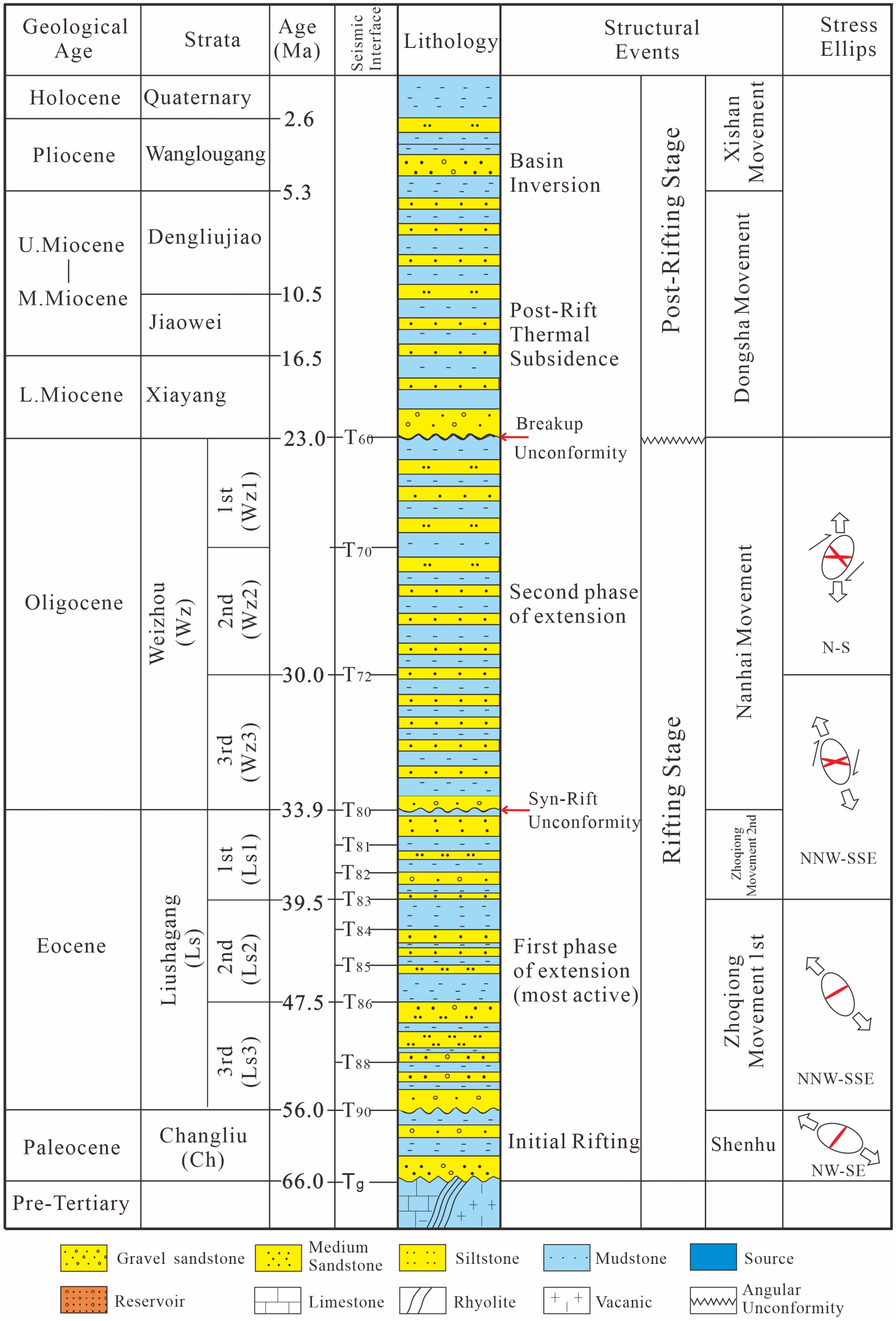


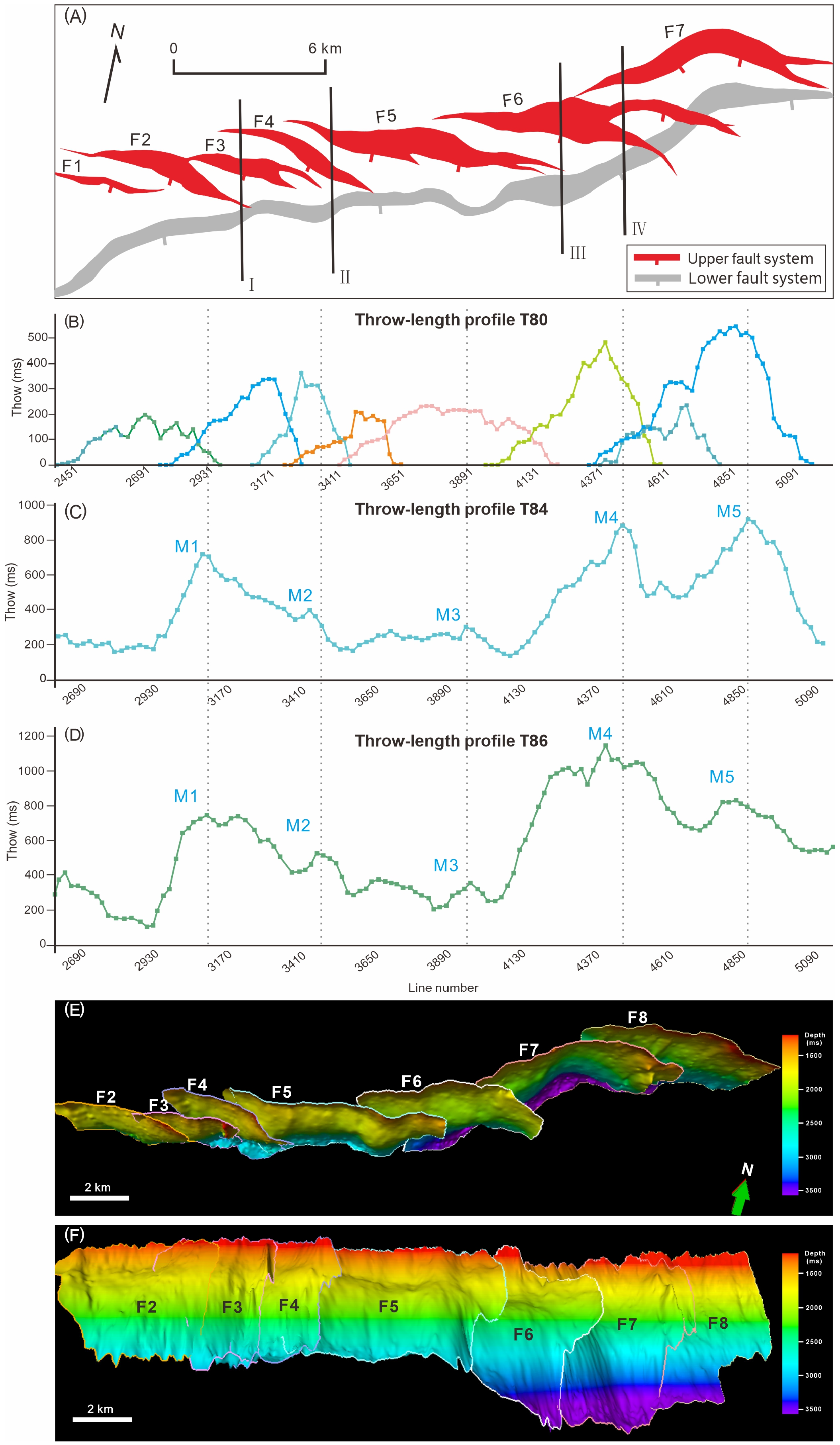
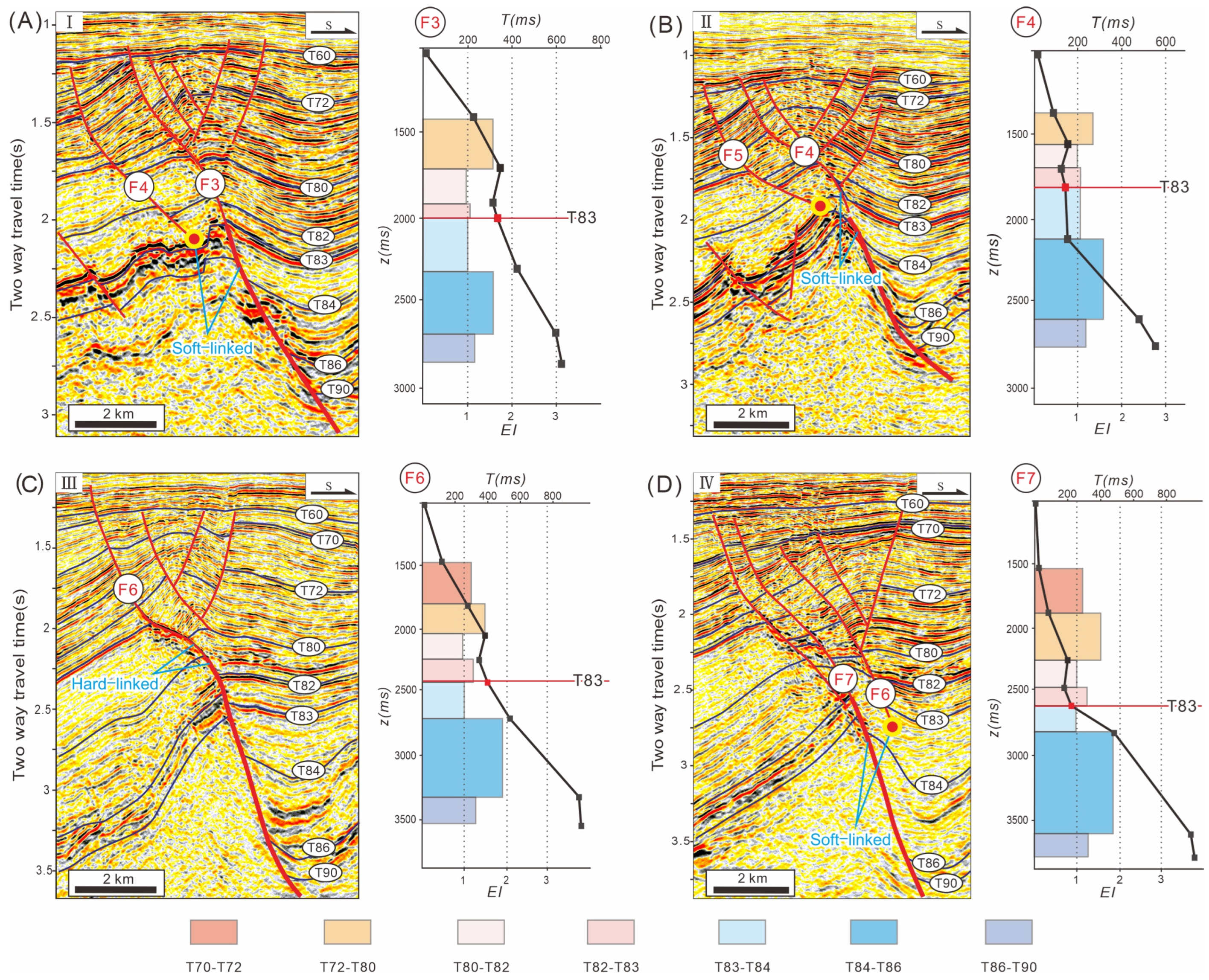
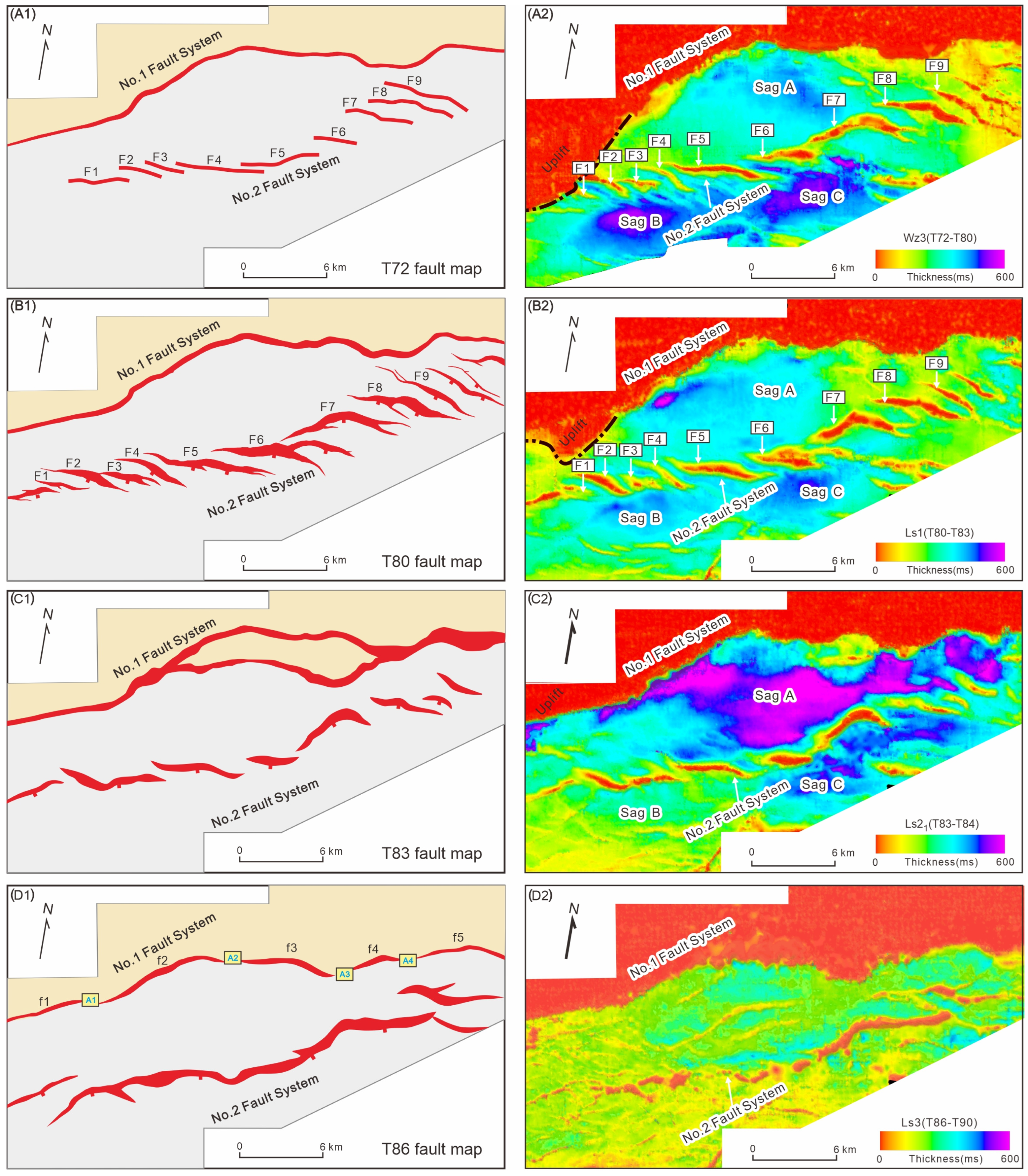

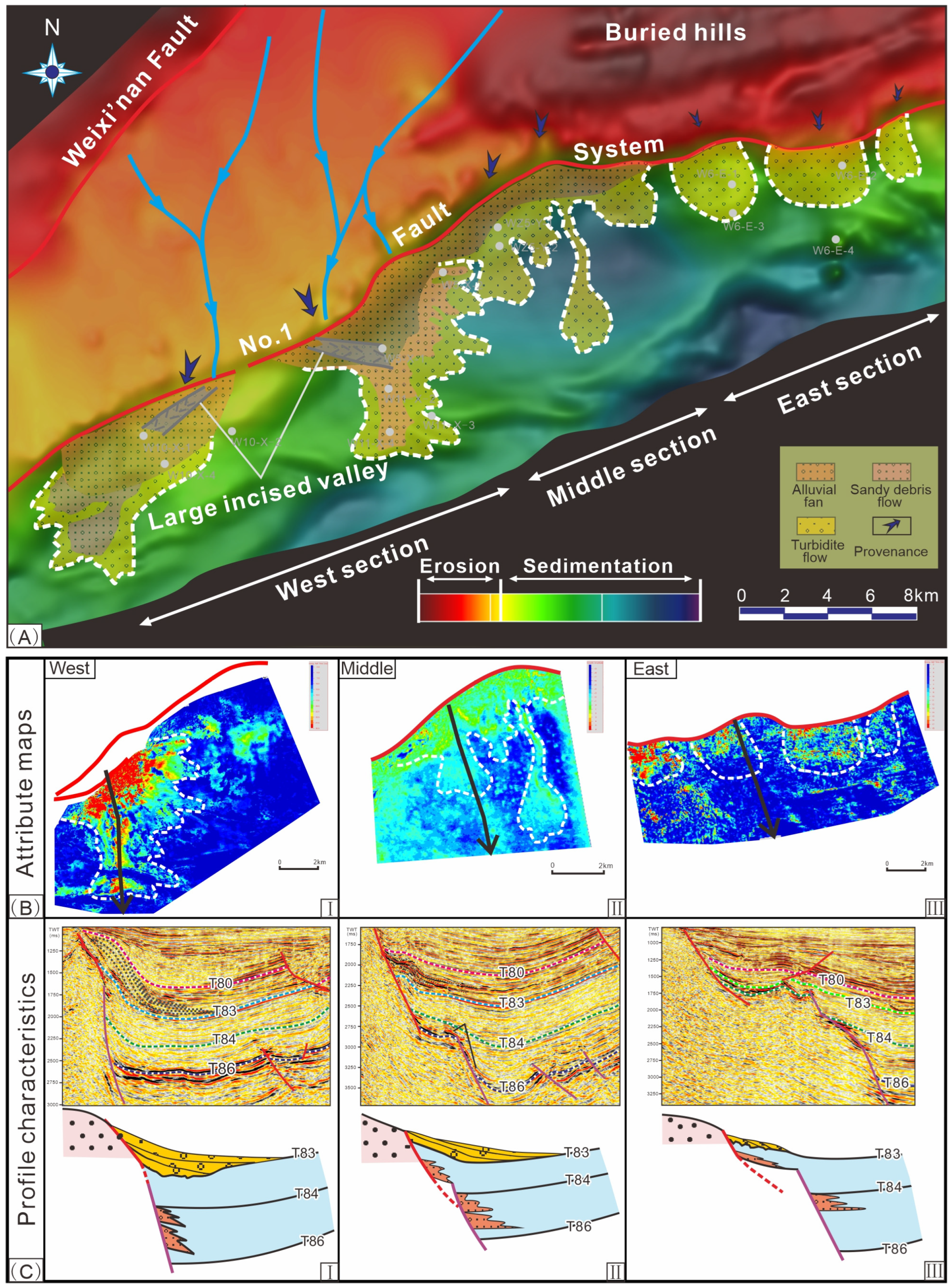
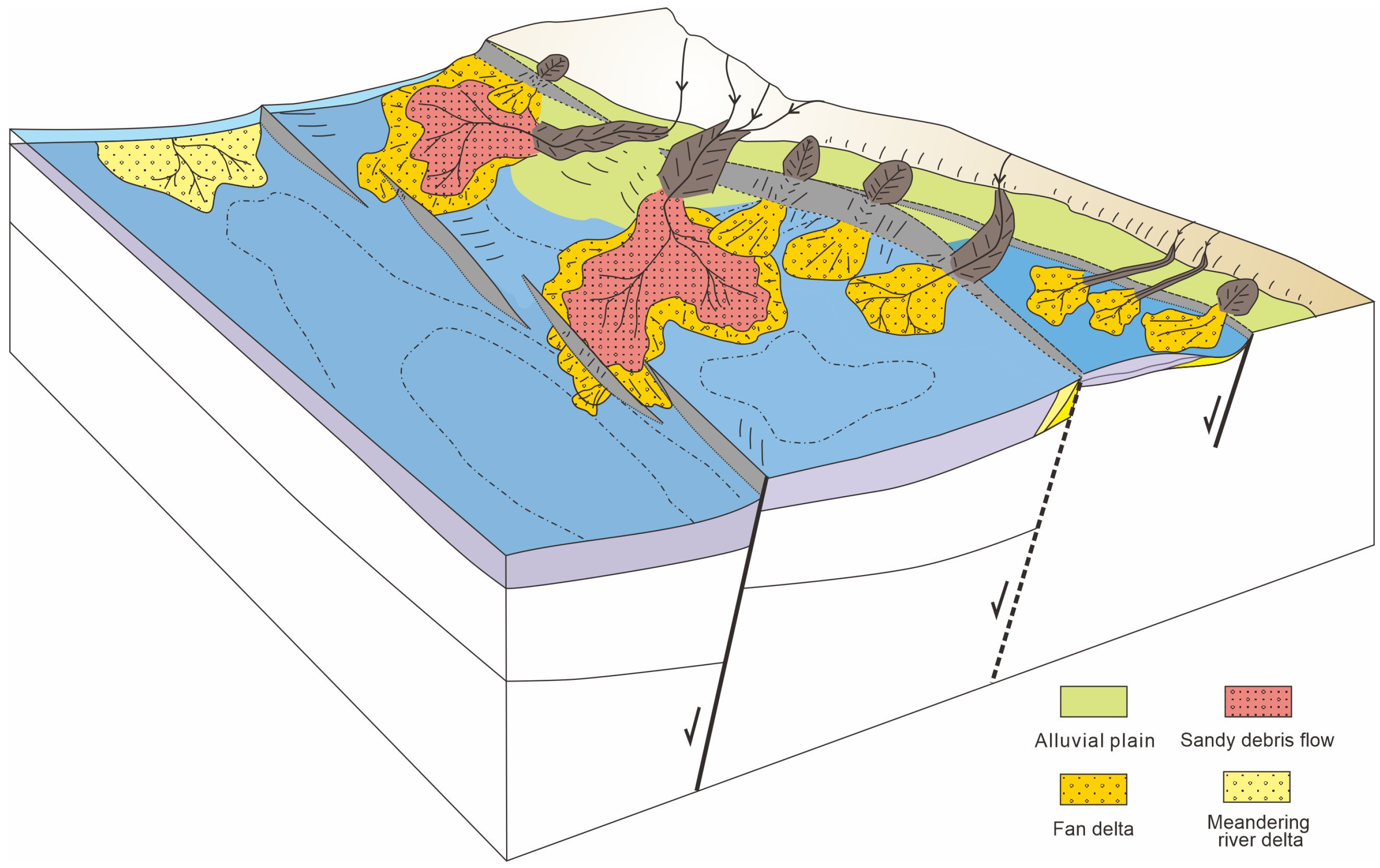
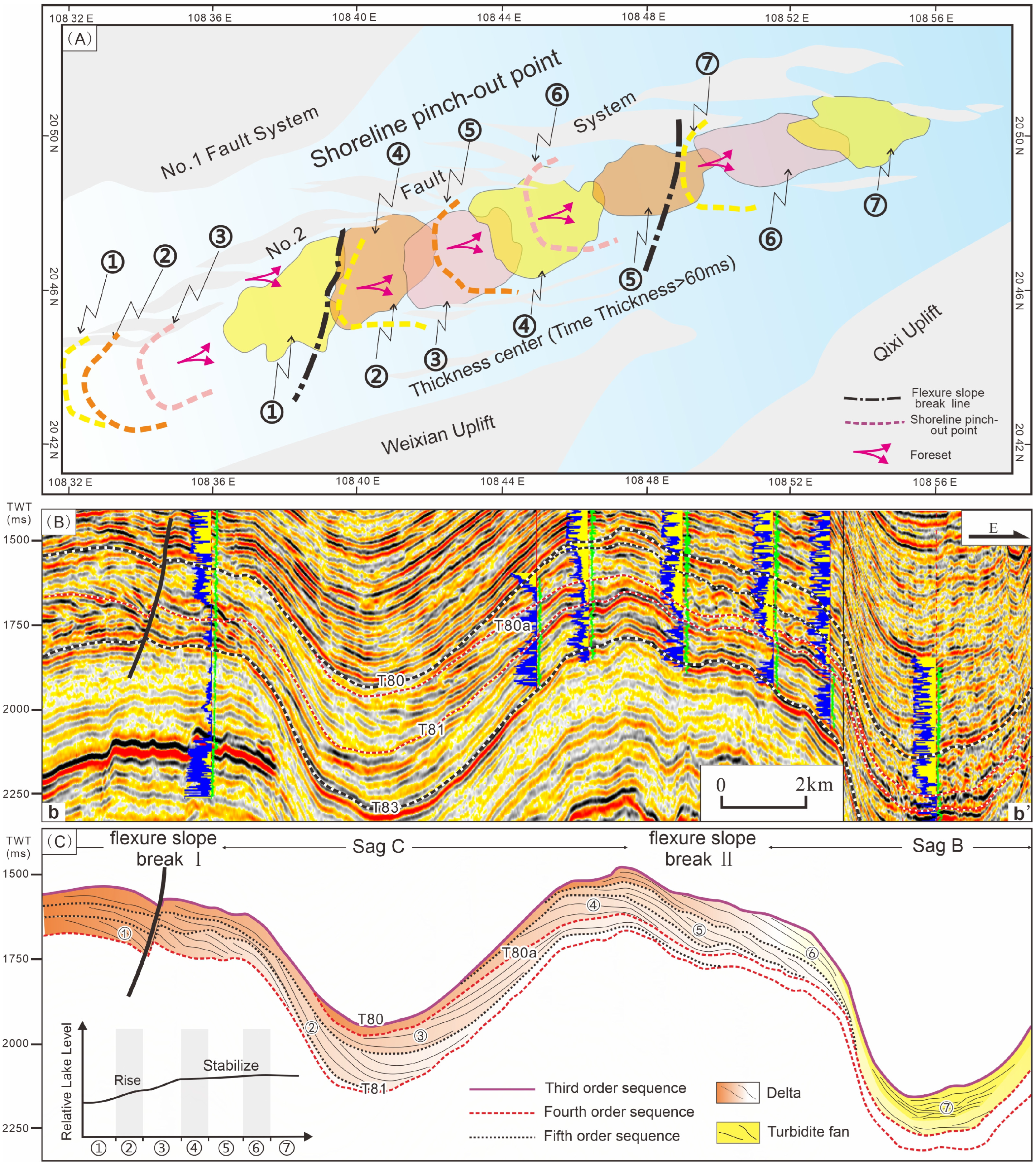
Disclaimer/Publisher’s Note: The statements, opinions and data contained in all publications are solely those of the individual author(s) and contributor(s) and not of MDPI and/or the editor(s). MDPI and/or the editor(s) disclaim responsibility for any injury to people or property resulting from any ideas, methods, instructions or products referred to in the content. |
© 2024 by the authors. Licensee MDPI, Basel, Switzerland. This article is an open access article distributed under the terms and conditions of the Creative Commons Attribution (CC BY) license (https://creativecommons.org/licenses/by/4.0/).
Share and Cite
He, J.; Qin, C.; Liao, Y.; Jiang, T.; Liu, E.; Chen, S.; Wang, H. Development of an Extensional Fault System and Its Control on Syn-Rift Sedimentation: Insights from 3D Seismic Interpretation of the Weixinan Depression, Northern South China Sea. J. Mar. Sci. Eng. 2024, 12, 1392. https://doi.org/10.3390/jmse12081392
He J, Qin C, Liao Y, Jiang T, Liu E, Chen S, Wang H. Development of an Extensional Fault System and Its Control on Syn-Rift Sedimentation: Insights from 3D Seismic Interpretation of the Weixinan Depression, Northern South China Sea. Journal of Marine Science and Engineering. 2024; 12(8):1392. https://doi.org/10.3390/jmse12081392
Chicago/Turabian StyleHe, Jie, Chunyu Qin, Yuantao Liao, Tao Jiang, Entao Liu, Si Chen, and Hua Wang. 2024. "Development of an Extensional Fault System and Its Control on Syn-Rift Sedimentation: Insights from 3D Seismic Interpretation of the Weixinan Depression, Northern South China Sea" Journal of Marine Science and Engineering 12, no. 8: 1392. https://doi.org/10.3390/jmse12081392






